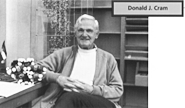

In our research group we design, synthesize, and test new kinds of host compounds used in the development of the new field of host-guest complexation chemistry. Hosts contain convergently arranged binding sites attached to concave surfaces, and are the synthetic counterparts of the receptor sites of enzymes, nucleic acids, proteins of the immune system, or ionophores. Guests have divergently arranged binding sites, and are either metal ions or the synthetic counterparts of substrates, inhibitors, or drugs. Complexes are composed of hosts and guests that are held together in solution in definite structural relationships.
Hosts are designed for catalysis, chiral recognition, and other forms of structural recognition of guests. They involve many of the functional and hydrocarbon groups of organic chemistry. Their syntheses require from 3 to 30 steps that include a wide variety of organic reactions. Once prepared, the hosts are tested to determine if they will perform the tasks for which they were designed. For example, hosts have been designed that are hollow spheres with eight pendant alkyl groups for solubilization purposes. They are formed by shell-closing, bowl-shaped compounds. The shell closures only occur when run in a solvent small enough to be imprisoned (a vacuum cannot be imprisoned). In carceplex 1, which exemplifies the idea, (CH3)2 NCOCH3 is imprisoned. Other carceplexes (such as 3, synthesized from 2) are being studied that have holes in their shells large enough to allow imprisoned molecules to escape and other molecules to enter. Molecules as large as anthracene have been "wedged" into 3 with heat. The chemistry of imprisoned molecules differs somewhat from that of molecules in solution. Another use of carcerands is to act as shields to protect unstable molecules from reacting with themselves. Cyclobutadiene has been synthesized photochemically inside of a molecule like 1 except one OCHO bridge is omitted. It is stable indefinitely at room temperature.
2. J. A. Bryant, J. L. Ericson, D. J. Cram, "High Preorganization of Large Lipophilic Surfaces Common to Two Complexing Partners Provides High Binding Free Energies that Vary Dramatically with Changes in Organic Solvent Composition," J. Am. Chem. Soc. 1990, 112 1255.
3. J. A. Bryant, R. C. Helgeson, C. B. Knobler, M. P. deGrandpre, D. J. Cram, "Host-Guest Complexation. 53. Functional Groups Preorganized in Hemispherands for Binding Alkali Metal and Ammonium Cations," J. Org. Chem. 1990, 55, 4622-4634.
4. J. A. Bryant, S. P. Ho, C. B. Knobler, D. J. Cram, "Spherands Containing Cyclic Urea Units," J. Am. Chem. Soc. 1990, 112, 5837-5843.
5. J. A. Bryant, M. T. Blanda, M. Vincenti, D. J. Cram, "Shell Closures of Tetrabenzyl Chlorides with Tetrabenzylthiol Cavitands Provide Carceplexes in Which One or Two Guest Molecules are Incarcerated," J. Chem. Soc. Chem. Comm. 1990, 1403-1405.
6. J. A. Bryant, M. T. Blanda, M. Vincenti, D. J. Cram, "Guest-Capture During Shell Closure," J. Am. Chem. Soc., 1991, 113, 2167-2172.
7. J. C. Sherman, C. B. Knobler, D. J. Cram, "Syntheses and Properties of Soluble Carceplexes," J. Am. Chem. Soc. 1991, 113, 2194-2204.
8. M. L. C. Quan, D. J. Cram, "Constrictive Binding of Large Guests by a Hemicarcerand Containing Four Portals," J. Am. Chem. Soc. 1991, 113, 2754-2755.
9. J. K. Judice, D. J. Cram, "Stereoselectivity in Guest Release from Constrictive Binding in a Hemicarceplex," J. Am. Chem. Soc. 1991, 113, 2790-2791.
10. D. J. Cram, M. E. Tanner, R. Thomas, "The Taming of Cyclobutadiene," Angew. Chem. Int. Ed. (Engl.) 1991, 30, 1024-1027.
11. J. R. Moran, J. L. Ericson, E. Dalcanale, J. A. Bryant, C. B. Knobler, D. J. Cram, "Vases and Kites as Cavitands," J. Am. Chem. Soc. 1991, 113, 5707-5714.
12. D. J. Cram, M. E. Tanner, C. B. Knobler "Guest Release and Capture by Hemicarcerands Introduces the Phenomenon of Constrictive Binding," J. Am. Chem. Soc. 1991, 113, 7717-7727.
13. D. J. Cram, M. E. Tanner, S. J. Keipert, C. B. Knobler "Two Chiral [1.1.1]Orthocyclo-phane Units Bridged by Three Biacetylene Units as a Host Which Binds Medium-Sized Organic Guests," J. Am. Chem. Soc. 1991, 113, 8909-8916.
14. D. J. Cram, H.-J. Choi, J. A. Bryant, C. B. Knobler "Solvophobic and Entropic Driving Forces for Forming Velcraplexes, Which are 4-Fold, Lock-Key Dimers in Organic Media," J. Am. Chem. Soc. 1992, 114, 7748-7765.
15. D. J. Cram, M. T. Blanda, K. Paek, C. B. Knobler "Constrictive and Intrinsic Binding in a Hemicarcerand Containing Four Portals," J. Am. Chem. Soc. 1992, 114, 7765-7773.
16. E. B. Schwartz, C. B. Knobler, D. J. Cram, "Six New Saddle Shaped Hosts Based on Fused Dibenzofuran Units," J. Am. Chem. Soc. 1992, 114, 10775-10784.
Fused Dibenzofuran Units," J. Am. Chem. Soc. 1992, 114, 10775-10784.